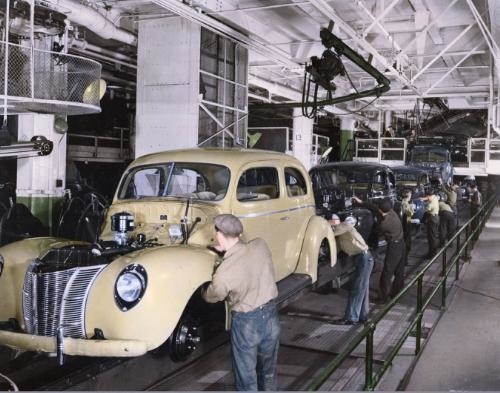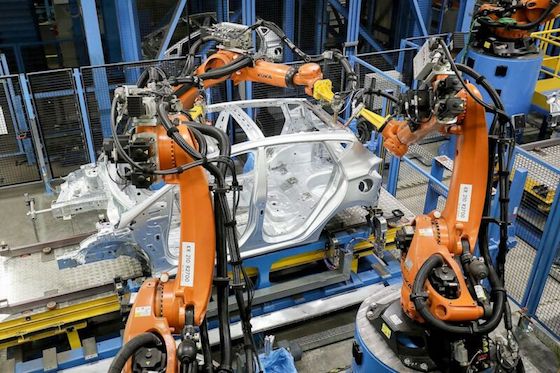Once upon a time, there was an implied contract between business and labor: employees supplied their energy and knowledge to build things for which companies paid them. The workers then used their wages to buy products made by business. It was a virtuous circle that made capitalism work for all concerned.
But now, the new technology of automation is increasingly erasing the worker from the equation, and the leaders of government and industry seem not even to notice the coming crisis of capitalism. In fact, the current occupant of the White House has opened the borders to future Democrat voters who will soon find a disappearing market for low-skilled labor because of smart machines.
In the modern factory, the “workers” are technology experts who use computers rather than wrenches.

A Ford automotive assembly line in the 1940s shows human workers building the cars.
Ford is also using artificial intelligence to speed production, and a company video gives a glimpse at the modern factory environment:
A recent article about an upgrade to the Ford automotive assembly robots is a reminder of how central smart machines have become to the company’s production process.
Ford’s ever-smarter robots are speeding up the assembly line, Technologynews.com, May 1, 2021

Ford is adding artificial intelligence to its robotic assembly lines.
In 1913, Henry Ford revolutionized car-making with the first moving assembly line, an innovation that made piecing together new vehicles faster and more efficient. Some hundred years later, Ford is now using artificial intelligence to eke more speed out of today’s manufacturing lines.
At a Ford Transmission Plant in Livonia, Mich., the station where robots help assemble torque converters now includes a system that uses AI to learn from previous attempts how to wiggle the pieces into place most efficiently. Inside a large safety cage, robot arms wheel around grasping circular pieces of metal, each about the diameter of a dinner plate, from a conveyor and slot them together.
Ford uses technology from a startup called Symbio Robotics that looks at the past few hundred attempts to determine which approaches and motions appeared to work best. A computer sitting just outside the cage shows Symbio’s technology sensing and controlling the arms. Toyota and Nissan are using the same tech to improve the efficiency of their production lines.
The technology allows this part of the assembly line to run 15 percent faster, a significant improvement in automotive manufacturing where thin profit margins depend heavily on manufacturing efficiencies.
“I personally think it is going to be something of the future,” says Lon Van Geloven, production manager at the Livonia plant. He says Ford plans to explore whether to use the technology in other factories. Van Geloven says the technology can be used anywhere it’s possible for a computer to learn from feeling how things fit together. “There are plenty of those applications,” he says.
AI is often viewed as a disruptive and transformative technology, but the Livonia torque setup illustrates how AI may creep into industrial processes in gradual and often imperceptible ways.
Automotive manufacturing is already heavily automated, but the robots that help assemble, weld, and paint vehicles are essentially powerful, precise automatons that endlessly repeat the same task but lack any ability to understand or react to their surroundings.
Adding more automation is challenging. The jobs that remain out of reach for machines include tasks like feeding flexible wiring through a car’s dashboard and body. In 2018, Elon Musk blamed Tesla Model 3 production delays on the decision to rely more heavily on automation in manufacturing. (Continues)
This story originally appeared on wired.com.